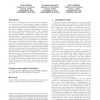179 search results - page 19 / 36 » A Category-Theoretic Approach to Social Network Analysis |
JSW
2007
13 years 7 months ago
2007
— Social network analysis has been used for quite some time to analyze and understand the behavior of nodes in the network. Theses nodes could be individuals or group of persons,...
KESAMSTA
2009
Springer
14 years 6 days ago
2009
Springer
ent Artificial Immune Systems (MAAIS) for Intrusion Detection: Abstraction from Danger Theory Chung-Ming Ou, C.R. Ou Ants-like Agents: a Model and Analysis Based on Natural Ants Be...
WWW
2011
ACM
13 years 2 months ago
2011
ACM
In this work, we study the notion of competing campaigns in a social network. By modeling the spread of influence in the presence of competing campaigns, we provide necessary too...
CHI
2006
ACM
14 years 8 months ago
2006
ACM
Social network-based systems usually suffer from two major limitations: they tend to rely on a single data source (e.g. email traffic), and the form of network patterns is often p...
EPIA
2009
Springer
14 years 2 months ago
2009
Springer
Abstract. In social network analysis, a k-clique is a relaxed clique, i.e., a kclique is a quasi-complete sub-graph. A k-clique in a graph is a sub-graph where the distance between...

